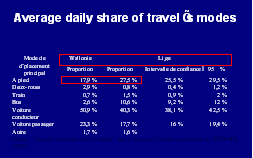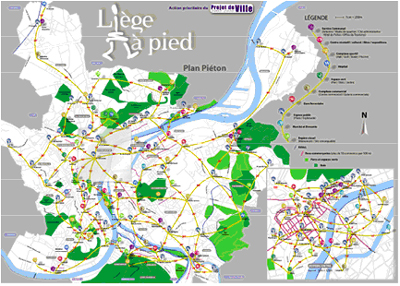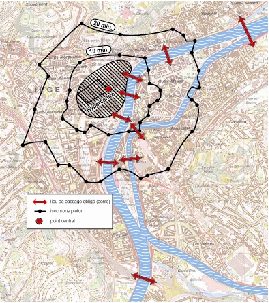 |
 |
 |
 |
 |
 |
 |
 |
 |
 |
 |
 |
Project description
Name of the case study
Pedestrian Master Plan for the city of Liege
Description of context
The city of Liége had a recent Municipal Mobility Plan, but this one does not really consider pedestrians even tough some arguments highlight the pedestrians´ challenges for Liège.
Soft mobility is promoted by E.U. and Wallonian Region. As a sustainable measure, the study of the Pedestrian Master Plan was half financed by the E.U. (FEDER- objective 2) and half by the wallonian Region, Belgium.

Examples of data preliminarily collected to make the diagnosis and identify challenges
Even if some Belgian cities have also a Pedestrian Plan, the Liège´s one is particular as it has functionality goals. Its developers mention that the only main comparable example is the Pedestrian plan of the French-speaking city of Geneva, Switzerland.

Public version of the Liège Pedestrian Master Plan, downloadable at http://www.liege.be/planpieton/
Description of project - background
The city of Liége had a recent Municipal Mobility Plan, but this one does not really consider pedestrians´ challenges for the city.
Available data and surveys put in evidence that in Belgium, Flemish people have more cycling habits and Walloons are more used to walk but the percentage of non-motorised distances covered are comparable for both Regions. More than this, Liége inhabitants walk proportionally more than Walloons. Financial resources of the population (36% don’t have a car) and good proximities of services have, among others, been identified as causes. Another important element is the recent increase of the use of car to covered distances from1 to 3 km.
The Federal Plan for Large Cities in Liége initiated the project and made the study proposal.
Description of project - objectives/aims
Pedestrian Master Plan developed as such is relatively rare. Usually pedestrian strategies focus on green and scenic spaces or on commercial centres, targeting tourism.
Here, the main objective is mobility: to connect 45.000 citizens in 20 minutes walking distance. Environmental and tourism concerns are balanced by social ones.

The area considered: 45 000 citizens; maximum walking distance of 20 minutes
The Pedestrian Master Plan is also looked at as a promotion and land-planning tool for the city.
Description of project - time interval and stages
The study proposal "A pedestrian plan for Liége" was made in May 2001.
In February 2003, the study began.
The Municipal Council adopted the plan by January 2004. At this date, a second stage of promotion of the Master plan and analysis of concrete urban developments project taking place in it started.
The project is still on going.
Description of project - financing
The E.U. (via FEDER funds) and the Wallonian Region funded the research project.
• The Federal Plan for Large Cities in Liége was the coordinator of the study.
• The city of Liége(department of Construction Works) assumed the administrative tasks.
• CITEC (CH) and COOPARCH (BE) were the 2 private agencies, experts in mobility consulted.
Description of project - other sectors involved
Even if they are collaborating at research level, departments of construction and environment are usually conflicting concerning urban developments and especially their economic aspects
What tools were used to assess sustainability?
Pedestrian Master Plan
More information